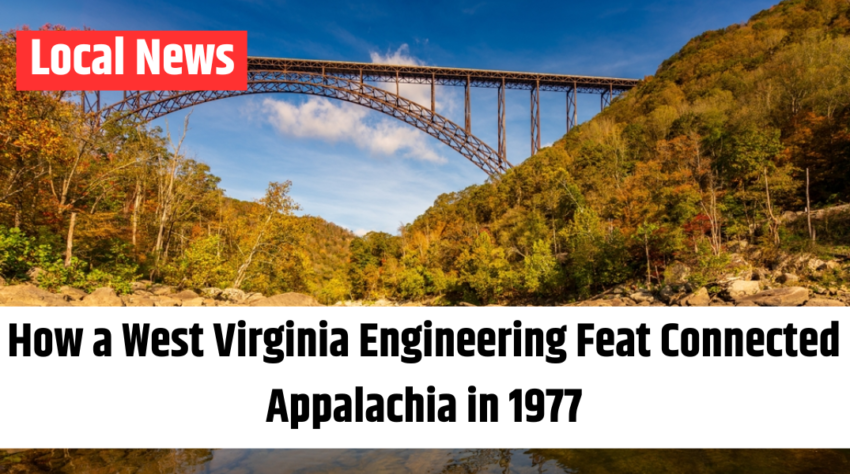Spanning an impressive 3,030 feet across one of North America’s oldest rivers, the New River Gorge Bridge is one of West Virginia’s most recognizable landmarks. Before its construction, travelers had to navigate winding, narrow mountain roads for eight miles to cross the deep gorge—a trip that could take nearly an hour. Today, the journey takes less than a minute.
A Record-Breaking Feat of Engineering
When it opened in the late 1970s, the New River Gorge Bridge held the title of the world’s longest single-span steel arch bridge. While larger bridges have since been built in China, it remains the longest of its kind in the Western Hemisphere and ranks third globally.
The bridge’s 1,700-foot arch supports a structure that soars 876 feet above the river, making it the tallest bridge east of the Mississippi River.
The Challenges of Building a Mountain Bridge
Constructing a bridge this massive in rugged mountain terrain came with unique challenges. Workers faced steep cliffs, unpredictable weather, and dizzying heights. Instead of traditional scaffolding, crews used cable systems similar to ski lifts to transport materials across the gorge.
Over three years, they pieced together millions of pounds of steel and concrete, ensuring the bridge was both strong and durable. Despite the risks, only one worker lost his life during the project—an impressive safety record for such an ambitious endeavor. The total cost of construction was $37 million, which, when adjusted for inflation, equals around $170 million today.
Why the Bridge Never Needs Paint
One of the bridge’s most remarkable features is its self-protecting steel. Built from COR-TEN steel, the structure forms a natural rust-like layer that prevents further corrosion, eliminating the need for painting.
This unique material not only reduces maintenance costs, but also gives the bridge its distinct rust-colored appearance, helping it blend seamlessly into the surrounding Appalachian landscape.
Also Read – NY Man Sentenced for Drug Distribution Scheme with WV Accomplice
A Home for Peregrine Falcons
The bridge’s towering height has made it an unexpected home for peregrine falcons—one of the fastest birds on Earth. Capable of diving at speeds over 200 mph, these birds use the bridge’s lofty vantage point to scan for prey.
Since the structure mimics the natural cliff faces where falcons typically nest, they return year after year during migration season, solidifying the bridge’s status as both a human and wildlife marvel.
Strength and Durability in Extreme Conditions
Designed to withstand strong winds, heavy rain, and extreme temperatures, the bridge features several engineering innovations that ensure its longevity.
-
Hundreds of drainage systems prevent water buildup on the road.
-
Wind-resistant tunnels allow air to flow through, reducing pressure on the structure.
-
The steel arch distributes weight evenly into reinforced concrete anchors embedded deep in the canyon walls.
Engineers even accounted for the Earth’s natural curvature when aligning the bridge’s massive steel components.
What Lies Beneath the Road?
Beneath the bridge deck, a complex network of steel trusses reinforces the structure. The bridge contains roughly 44 million pounds of steel, ensuring it remains safe and stable even under heavy traffic.
Special inspection vehicles equipped with cameras monitor the bridge regularly, while hidden sensors track any movement in the steel framework. The road itself is slightly sloped to direct water away from the driving surface.
The Best Spots for Bridge Photography
For breathtaking views of the bridge, visitors head to the Canyon Rim Visitor Center, which offers three viewing platforms. Photographers can capture stunning seasonal changes, from foggy spring mornings to the golden hues of autumn leaves.
Sunrise and sunset provide the most dramatic lighting, casting long shadows across the gorge and highlighting the bridge’s intricate steelwork.
Thrilling Adventures at the Bridge
Every year, adrenaline seekers gather for Bridge Day, the only time BASE jumping is legally allowed from the bridge. Jumpers free-fall from the 876-foot-high span, making it one of the most famous BASE jumping sites in the country.
For those seeking a less extreme adventure, guided catwalk tours let visitors walk beneath the bridge, offering unparalleled views of the gorge below.
Also Read – West Virginia Lawmakers Repeal Local LGBTQ+ Protections in Controversial Vote
What the Bridge Looks Like at Night
Unlike most large bridges, the New River Gorge Bridge has no streetlights. This helps reduce light pollution and protect local wildlife.
On clear nights, the bridge’s silhouette stands out against the starry sky, making it a popular spot for stargazing, especially during a full moon.
How the Bridge Revolutionized Travel
Before the bridge was built, crossing the New River Gorge took 45 minutes on treacherous, winding roads. Today, it takes just one minute to drive across, dramatically improving transportation and commerce in the region.
Each day, more than 16,200 vehicles use the bridge, with traffic peaking in the fall as visitors arrive to see the vibrant autumn foliage.
Designed for Harsh Weather
The bridge is built to withstand extreme conditions, from heavy snowfall to intense summer heat. Its steel framework can handle four times the typical weight load, and its deep foundation—40 feet into solid rock—ensures stability.
A Lasting Landmark
With its ingenious design, record-setting span, and breathtaking views, the New River Gorge Bridge is more than just a crossing—it’s an icon of engineering and a beloved West Virginia landmark.
